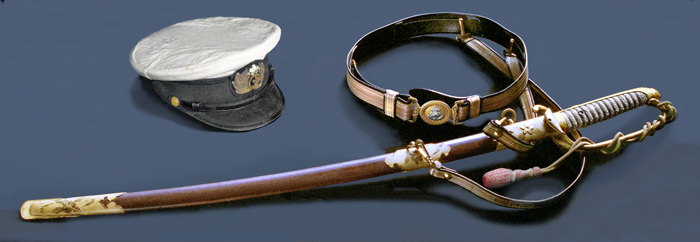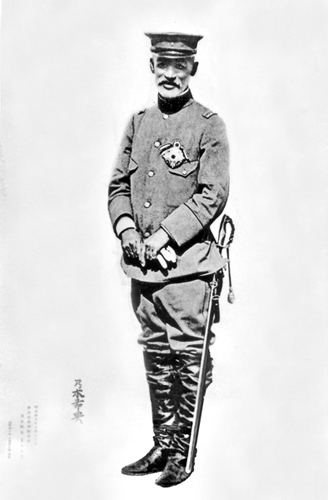The old Guntō 0
Commissioned officers Kyū-Guntō
 The naval Kyū-Guntō, and the sword
belt used for an admiral's full dress.
The naval Kyū-Guntō, and the sword
belt used for an admiral's full dress.
Imperial Japan's army and navy received instruction of the France
army and Royal Navy at the time of foundation of national army.
Therefore, all the military swords for an officer, a noncommissioned
officer, and a private were Western sword mounting (saber). The navy is
enacting the saber mounting frequently from 1870 to 1914. However,
unlike the iron scabbard of an army sword, a scabbard is a black
leather or yskin binding wooden scabbard, and a suspension mount and a
chape are splendid shapes. However, the marine corps was the iron
scabbard same till 1876 as an army.
The blade of the government supply saber for a noncommissioned
officer and a private was a machine-made blade with the
swod-tang which used Western iron (a saber metal or sword steel of a
military-rules rank), and was united with the
shape of the hilt of an one hand grip.
However, the officer's tendency which chooses a traditional
Japanese sword was strong.
For that purpose, the shape of the sword-tang of a Japanese sword
needed to be processed impossible. On the other hand, the hilt of the
one hand grip of the Western sword form for stabbing did not adapt
itself to Japanese traditional cutting usage except for the department
of a cavalry trooper.
The saber mounting of the both-hands grip appeared in order to
solve these problems.
In 1932, the army improved the hilt of a noncommissioned
officer's Type 32 saber in Japanese sword form (Type 32 advanced type).
Furthermore, the army adopted the new military swords for an officer in
1934. It was late for the army for three years, and the navy adopted
the new military swords for an officer in 1937. As for the old saber, a
very variegated variation exists by the difference of a hand-guard, the
backstrap of a hilt, the number of suspension mounts, a convex
engraving pattern, a coating color, and etc. until a new military
swords is adopted.
Armies and naval officers did not necessarily change all into a
new mounting, after a new military swords was enacted.
The officer of the age which carried out the carrying of the
Kyū-Guntō from the former, and the young officer who inherited the
Kyū-Guntō continued using these Guntōes to the end of the war. There
are many such examples.
Earl, Full general Maresuke Nogi
General Nogi commanded the Lushun capture as the third team
commander in the Russo-Japanese War.
Many Japanese soldiers were killed in the severe battle of 203
high grounds. In spite of it, General Nogi dealt with enemy General
Stessel like a gentleman at the Suishiei interview. This act of his
became known widely in the whole
world as "Bushidō."
He was excellent in the talent of Chinese poetry, and led simple
life by honest character covering the whole life.
Night of September 13, 1912, he killed himself on the death of
his master with Mrs. Shizuko according to Emperor Meiji's death. He had
his death and showed the loyalty to the Emperor. This is the zenith of
loyalty. This martyrdom gave a great shock to in and outside the
country, and was admired as a type of "loyalty." General Nogi was a
members of the armed forces representing Meiji.
General Nogi's death marked the end of the time of Meiji where
the
tradition of old good Japan had breathed.
This photograph is General Nogi of the director time of Gakusyūin.
1
The table of
contents of the Kyū Guntō 
Army Kanesda & Mumei
Army Nagamichi & Sukesada mounting
Navy Mumei Adomiral Tōgō's Yoshifusa
January 8, 2014 
To
the top of a page ▲



